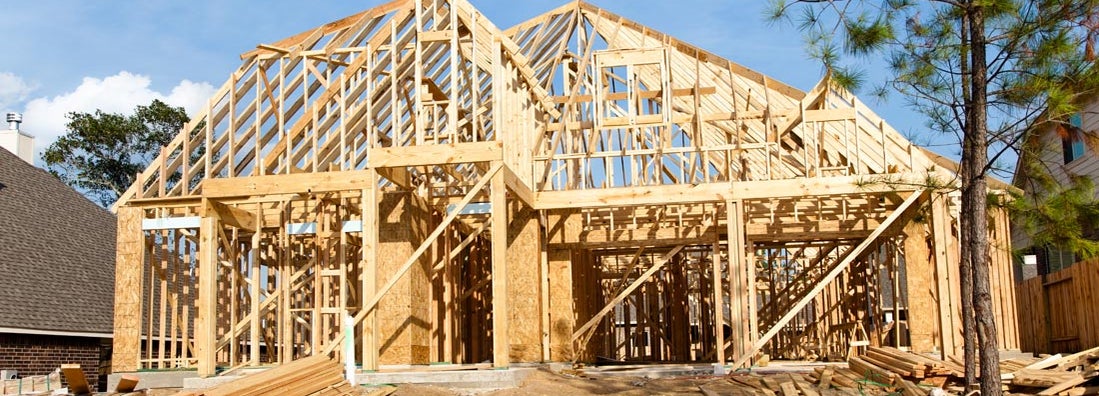6 Easy Steps to Building a House

Building a home; what a great way to get exactly what you want in a place to live and fill up all your free time for the next several months at the same time. But you’ve probably already got your mind all made up, so we’re just here to help make sure your new house gets built with as few snafus as possible.
We’ve put together this little step-by-step guide to help take some of the load off your shoulders and get that metaphorical ball rolling in the right direction. But first, make sure you're covered with an affordable home insurance policy.
Step 1: Plan, Plan and Plan Some More
The planning stage of building a home is arguably the most important of all. This is definitely not the time for any sort of half-assery. You can’t just point to a spot, say, “I want it there” and be done. Laying out the proper groundwork in the beginning will help make everything easier and less stressful, and may even speed things up.
So what exactly do you need to plan? Well, everything honestly. But before you do anything, you need to figure out what type of house you want. So start by asking yourself the following questions:
- Will I be raising a family in this house?
- Do I want a yard?
- How much privacy do I want from my neighbors?
- Do I want to be able to entertain in this house?
- Do I want one or two stories?
- Will I stay in this house forever?
- What type of climate am I building in and what do I need to adjust for that?
- If I get really old in this home, do I need specific safety features?
Knowing the type of home you want to build will help determine the property, the cost, the scope of your project and your curtain style, to boot.
Step 2: Determine the Layout of the House
It may seem as simple as just knowing that you want three bedrooms and two baths, but the overall house layout is still a huge thing to think about. Do you want a split-level layout? Do you want an open floor plan? Do you need one man cave or two? These are important things to think about when laying out your new home. Overlooking even the smallest thing can leave you stuck in a poor situation for years to come. So as you get started, make sure you avoid these common house building mistakes:
- Creating pointless rooms that aren’t used: Because four rooms for your trophies is a bit of overkill.
- Poor placement of the laundry room: Hint: Most people prefer it to be close to the bedroom, where the hampers are.
- Poor placement of the bedroom: Don’t put your bedroom next to the kids’ play room.
- Poor placement of the kitchen: Kitchens work best near a main point of entry; that way you can walk straight to the fridge for some chocolate milk when you get home from work.
- Placement of the garage: Consider how much foot traffic and general stuff will come in through your garage and determine which part of your house you want it tracked through.
- Poor lighting: Don’t forget windows and lights, so you don’t end up living in a dark cave.
Once you’ve dodged these common no-nos, take the size and use of each room into consideration. Don’t forget things like storage space and closets, but also don’t go building things you’ll never need, like a cheese cellar. And be realistic when it comes to what you really need, because no one needs a walk-in closet larger than their bedroom, no matter how many different types of black shoes they have.
On The Dave Ramsey Show, budget and financial know-it-all Dave Ramsey recommends connecting your builder with your architect during this stage and says:
“Involve your builder with the architect, so the two of them are working together to develop the plan…[This is] so the architect’s not drawing you something stupid that’s ridiculous to be built or super expensive because they went to art class and don’t know anything about building. You have to have the balance in there.”
After all, if you want a boat ride to stay on course, you better make sure everyone’s rowing together, that’s just science.
Step 3: Budget Properly
According to the house designers web page, no final bill on a house ever comes in under budget, and most times they come in quite a bit over what was expected.
The things that usually end up increasing the budget unexpectedly include upgrading specifications, structures or materials as you go, building material cost overruns, and even Mother Nature’s weather tantrums.
So make sure you plan some significant wiggle room into your budget beforehand, lest ye be very unpleasantly surprised when it’s all said and done and you’re stuck searching in couch cushions to make up the rest.
Step 4: Find the Right Professional Help
Few people, other than the pros, have a substantial amount of expertise in the house building process. Which is probably why you’re here, halfway through an article on the subject.
That’s why you’ll need to call in some professional help. And when choosing your builder and architect, understand you’ll be spending more time with them than your own kids, so make sure you pick out some good ones. Erin, from The Sunny Side Up blog, recommends vetting all your options, and writes:
“Interview and meet with lots of builders and ask for referrals,” and continues by writing, “It’s also smart to ask for names and numbers of the last three people they worked for to get an accurate view of how people felt about their building experience with that builder. Look for clues that tell you what they will be like to work with.”
Beside a builder and an architect, you'll most likely be working with a real estate agent or buyer’s agent, subcontractors, painters, roofers and lots of other tradesfolk. This is no time to be cheap with your help, you want people that you feel confident will come through for you.
Step 5: Seek Advice from Other Home Builders
This can really happen at any stage of the building process, but before you start putting hammers to nails, hit the Web. There are countless articles, forums, blogs and Facebook groups for house builders just like yourself that can provide some much-needed support. Some of the favorites we came across include:
- 10 Things I Wish I Knew Before I Built My House
- Home Building Forum on Houzz
- Facebook Home Building Groups
You'll find that many other people have already walked this trail, so you may as well hear their tales, avoid their hurdles and make their wrong turns go right for you.
Step 6: Build It
If you’ve gone through these first five steps and double- and triple-checked your list, you should be ready to build. But as you can imagine, there’s an order to things. It’s like Nana always said, “You can’t put a toilet in the bathroom if there is no bathroom.” Here's the common building order according to HowStuffWorks:
- Grading and site preparation
- Foundation construction
- Framing
- Installation of windows and doors
- Roofing
- Siding
- Rough electrical
- Rough plumbing
- Rough HVAC
- Insulation
- Drywall
- Underlayment
- Trim
- Painting
- Finish electrical
- Bathroom and kitchen counters and cabinets
- Finish plumbing
- Carpet and flooring
- Finish HVAC
- Hookup to water main, or well drilling
- Hookup to sewer or installation of a septic system
- Punch list
It's always best to have a detailed schedule of the build so you have a good idea of the progress as it’s happening. It also helps organize certain steps, since construction professionals usually need to be scheduled out months in advance. A detailed schedule will also allow you to know when your builders may be getting off track, over budget, or just need a some positive reinforcement.
And on one last side note: Erin recommends being kind to everyone involved in your building process. Remember, you’re all in this together.
"Framers, cement crew, drywall installers, electricians, painters, carpenters, etc. – we got to know them. We made them feel welcome and appreciated,” said Erin.
It’s kind of like eating out at a restaurant. If you treat your waiter like dirt, you proooobably won’t get the best service. And that’s just one dinner, here we’re talking about your entire house! So treat the crew like you want them to treat you and everyone wins in the end.
And that’s the outcome we’re hoping for, happiness all around. If you follow these simple steps and learn a few deep breathing exercises, your build is going to go great. Good luck, and make sure you're covered with an affordable homeowners insurance policy.
https://www.youtube.com/watch?v=99vVvznj0P8
https://home.howstuffworks.com/home-improvement/repair/house2.htm
https://www.thesunnysideupblog.com/
https://www.housebeautiful.com/home-remodeling/interior-designers/tips/g569/what-i-learned/?slide=10
https://dengarden.com/misc/new-construction-home-building-tips
https://www.thehousedesigners.com/articles/7-tips-for-building-your-first-home.asp
